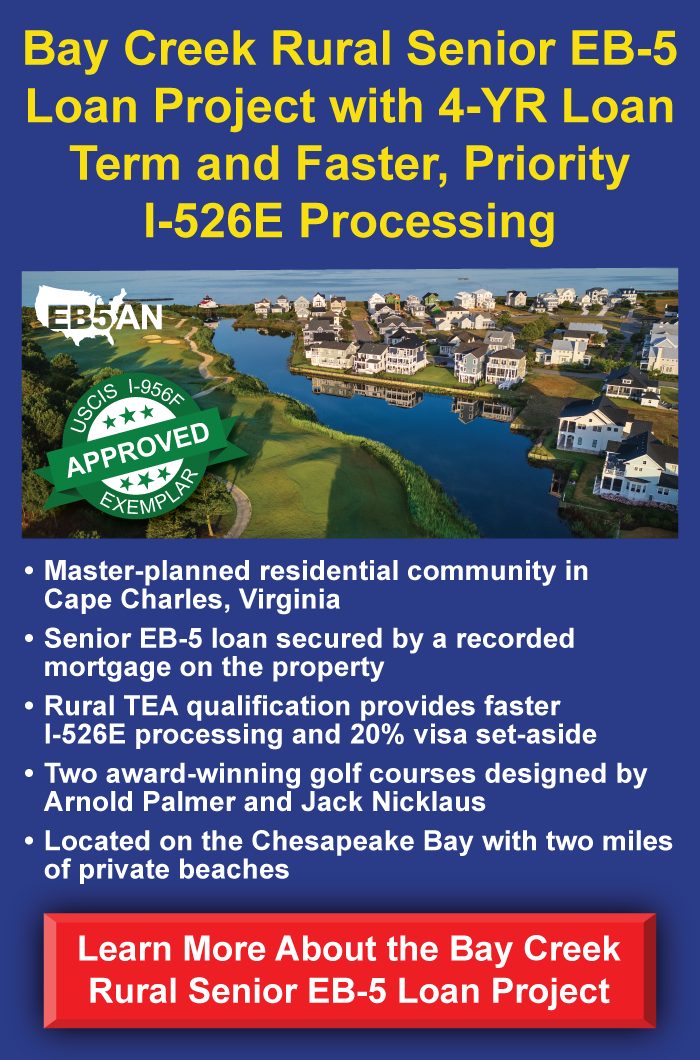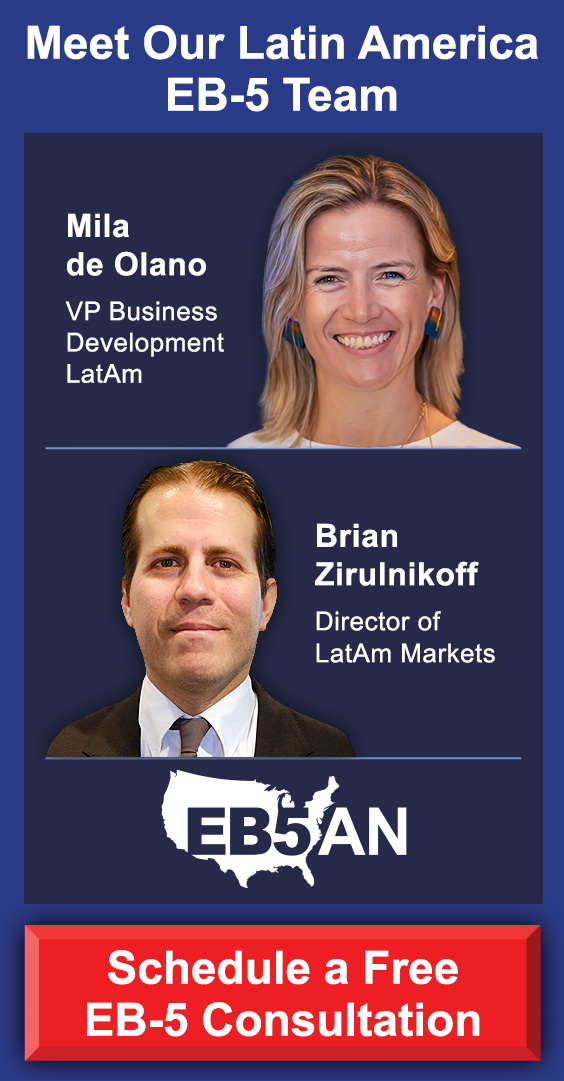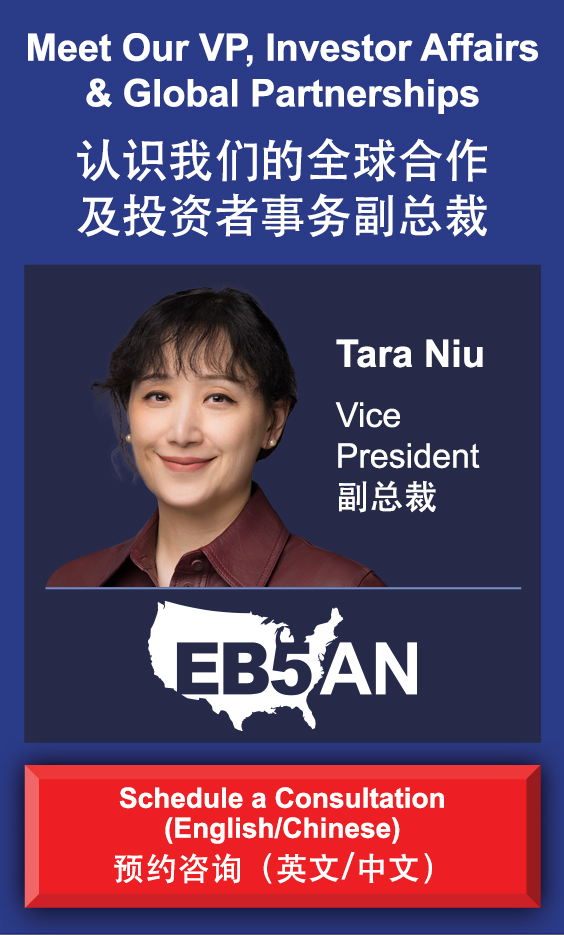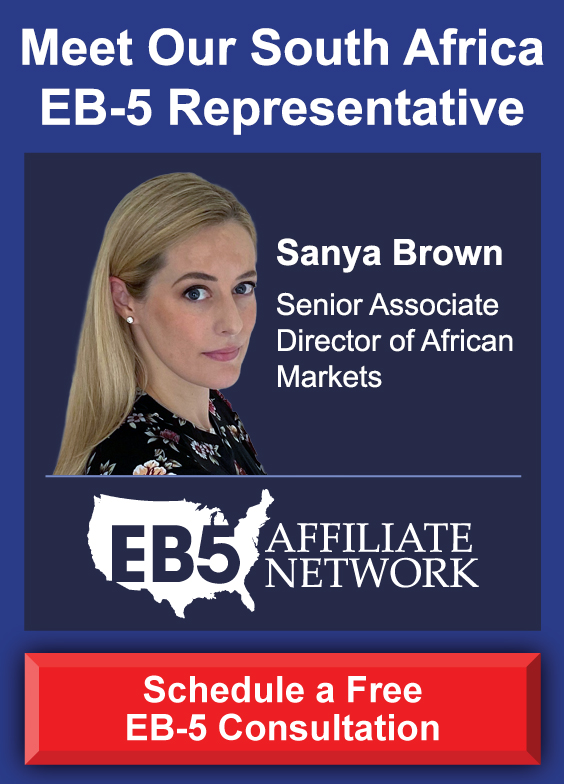Select Highlights of the Interview with Deepak from India
EB-5 Investor in the EB5AN Rocky River Rural EB-5 Project
- So why Rocky River? One is solid economic fundamentals. For those of you aren’t familiar, they have this Cresswind brand of properties, which really catered to active, old communities […] People need housing, and then this is targeted towards a particular segment. And a couple of other things which stood out.
- It’s really the track record of Kolter. If you’re looking, I think they’re one of the top 20 of the largest real estate company or something. It’s really about have they done the track record of doing similar projects.
- When I spoke with other regional centers, some of them had some sort of documentation but not with this level of comprehensiveness […] EB5AN stood out.
Full Interview with Deepak from India
EB-5 Investor in the EB5AN Rocky River Rural EB-5 Project
Transcript of the Interview with Deepak from India
My Background as an EB-5 Investor
Hi, everyone. I’m Sam Silverman, managing partner of EB5AN. Thank you for taking time to join us for today’s video testimonial. Today, we’re going to be speaking with Deepak from India, a real EB-5 investor in our Rocky River rural EB-5 loan project, and we’ll be chatting with him about the process, what it was like hiring an immigration attorney, going through the source of funds process, and then researching potential EB-5 investment projects and then ultimately why he decided to select the Rocky River rural EB-5 project with Kolter.
Yeah, sure thing. Hello, everyone. I’m Deepak. Sam, thanks for having me here, and look forward to chatting through my experience. I’m Deepak. I grew up in India. We currently live in California with my wife and kid.
I think one of the first question is what led me to pursue the EB-5. So we want to really talk through where we are coming from. We have a work permit, which is H-1B, and we also have I-140. But as you’re familiar, the Green Card wait is long, and with this work permit, the travel is restrictive, where you have to get stamping, which means there’s a lot of restrictions.
We were looking for more certainty. We wanted to travel without restrictions and live freely. So EB-5 stood out as the path which is very clear. That’s the reason why we pursued EB-5 opportunity, so that we can travel unrestrictedly in and outside the U.S. and live here.
Yeah, that’s a good one. With the current work permit, the H-1B, you’re tied to an employer. With the EB-5, you’re not really tied to an employer, so that was one of the major pluses as well.
That’s a good one. We didn’t really consider other options. There is EB-1A, and there’s other employment-based options. Again, end of the day, it is really subjective what really resonate and works for us. For us, I felt that EB-1A is subjective criteria, and you really have to spend a lot of time building a profile, which means that there’s a lot of time commitment. And the employment route also means that you have to temporarily leave the country.
With all of the options, we did a quick analysis, the pros, cons, and what’s really a close fit for us given the stage we are in. EB-5 was a much clearer option we wanted to pursue. That’s the reason why we doubled down on EB-5.
Finding an EB-5 Immigration Attorney
Yeah. Once we really figured out EB-5 is the path we want to take, there were two tracks. One is finding the right EB-5 opportunity, or the project, and the other is finding the right immigration attorney. I’ll focus on the immigration attorney pieces.
I did a bunch of research. Also, whenever I talked to Narshe, I also asked for referrals, so I ended up having roughly around eight to nine attorney referrals. I narrowed down to maybe five attorneys, and I spoke with all five of them.
All of them are great. It really depends on what you’re looking for. It’s really a combination of what’s a resident fit. Some are more personal, some of them are standardized and rigorous, and most of them sat on the attorney board. So you need to do a bit of research. And I did talk to all of them.
After talking to the five attorneys, I ended up with Joey Barnett, because his profile and the way he worked resonated with my style. So I went with that attorney.
Yeah. Of the five I spoke, three of them were like a close call. But here are some things which I encourage people to look into it.
You should really look for a good track record—not just working on any of the casework, specifically EB-5. The hundreds or thousands of cases they do, which means they’ve done it in and out; they would’ve come through all kinds of cases. So that’s number one: track record in EB-5.
Two, someone who work with the kind of projects you’re interested. So it’s really the regional center and the kind of funds you’re dealing with.
Three, it’s also about being on the advisory boards of EB-5, advisory board. So you should really look into those three metrics.
I looked into those three metrics. I think two or three of them are really close. And then, when you really talk to them, it’s really more about their working style and your working style.
Some of them are more—how do you say?—personal, and they get more subjective. It’s a lot of personal advice about what personality clicks with them. Even if I’d gone with others, they were all great.
But I really liked Joey. So I really talked to this attorney, and I really felt it’s more of a personality fit, in addition to having all those things I mentioned, the three criteria I mentioned. I broadly looked into each of those attorneys.
So that’s how I ended up picking the attorney I’m currently working with, and it’s been a great experience so far.
When I spoke with the attorney and his team, so that was an orientation call. So he really talked through about what you really have to expect, and then it was a clear email instructions about what to really expect.
So really taking a step back, source of funds documentation is the one which is going to really take a lot of time in getting all the documents. I had done some prep work, but despite that, I didn’t really spend a lot of those times really getting the right documentation. If you really think about source of funds, some of them are easier— like getting your bank statements, easier—but if you were to look at … Before we even go there, what are some source of funds people expect? It’s really all the documents which really show that you lawfully earned the funds here, which means the bank statements, the pay stub, the tax returns, everything else to really bolster the claim is going to be helpful, and that’s what you’re trying to really assemble here. Some of them were really … The older you get, maybe the seven-year-old tax return or something else you need, that took a little bit of time.
But for the most part, it’s really about just keeping focus and just cranking through the work list of getting each of the documents. It’s also an iterative exercise. You have a checklist, and you keep flowing through that checklist and just crossing off items—like pay stubs, you got it; tax returns, you got it, right? There’s a lot of back-and-forth between you and your source of funds team. It took us roughly around sixish weeks to get to 99% of the documents.
If you were to really give some advice, it’s about start early, because there’s a lot of documents you have to collect. The more sources you have, the more prep work you have to do getting the right documentation. But if you really work with an attorney who has really done all of this, they really take you through it. It’s not that it’s ambiguous. I think it’s just that it takes time to get all that documentation in the right format your team asked you to really get to them.
I think some of those just older pay stubs, older than three years. If you already changed jobs, you don’t really have access to the old employee portal. Short answer, the bank statement is something you can pretty much get to. You log into your bank—you just really get most of them. But some of those which is tied to your previous employer, so if you’re no longer with the firms, then you really have to go to the portal and make some ad hoc requests. That took me by surprise. But again, it’s something you can easily work through. You just have to do an email outreach, and they will get what you really need. But that’s something which I wasn’t hoping I needed, but then I ended up going that route, and it was a little bit of a surprise. Yeah.
Yeah. I would really have a two- to three-week timeline to really find the right attorney fit. It’s great talking to the regional centers. They give referrals. You do have to do some research. You have to really do some prep work. The more prep you do, the more compressed you can really get. I talked to the regional centers, got the referrals, then I did a bunch of screening. You can always just Google them—what do they do, their profile, how many applications have they filed, read about the law firms. A lot of them are easily available online. That was a two- to three-week exercise in trying to find the right one. You also have to block time with each of them to do it to get a feel which attorney vibes with our working style. That’s a good three-week timeline.
And the source of funds, it’s around … It could have been more compressed if you weren’t traveling for work or for leisure. So that took around sixish weeks. I’m also including a one- or two-week break. We were traveling for vacation. So it’s roughly around sixish weeks.
You should really allocate somewhere between two months. It took us two months, but again, it could be quicker if you’re fully focused. But that’s a give-and-take. That’s a ballpark timeline applicable in our case, yeah.
In terms of the top two or three, the number one, do a lot of prep work, especially all the kinds of documents you can assemble. Your attorney is going to help you, but do a lot of prep work before. The sooner you really think through all those cases, the faster you can turn around. That’s number one.
Number two, finalize your attorney sooner. The only thing is I wish I had done the source of funds sooner. That’s the thing—don’t really underestimate the level of effort required to get the source of funds documentation buttoned up. Start that sooner. That means you have to start your attorney sooner.
Those are the two things I think [inaudible 00:12:52] advice, but those are the two things I recommend for folks to really think about. Yeah.
Why I Selected EB5AN and the Rocky River Rural EB-5 Project
Yeah. I talked about it. There are two tracks. One is the attorney and the source of funds track. I’ll address finding the right project fit.
Taking a step back, the first thing I was trying to do is … I searched a lot about the EB-5 projects. Then there is two major broad ways: One is going by regional center and going by the direct route. I felt regional center route is the path of least friction, because as someone who has a full-time career, you would rather go with regional center, which is very transparent and get you all those updates. I prefer the regional center. So I spoke to four of them.
As you start talking to every regional center or go through the projects they have, you start thinking about the pros, cons of each regional center. So what are some of the things you need to think about it? You should always look for a regional center with a good track record and also the varieties of project which is more closely aligned with your own background, institution, circumstances.
There I would really frame it as the rural versus urban. Especially coming from India, if you were to go via the urban or the HUA route, it’s going to take a long time, and we wanted to prioritize a faster timeline for Green Card, or conditional Green Card, so went by the rural route.
Taking a step back, you need to look for that track record. You need to look for the kind of project which resonates—in our case, it’s the rural EB-5 projects. Those are the two things.
We started comparing different regional centers, and we narrowed down the regional center. In addition, you also start noticing which regional center gives you more documentation, more transparent, more clearly communicates. It’s really a series of factors. But those are really the broad two, three conditions which really help us to really go with the one regional center. In this case, it’s EB5AN.
Yeah, that’s a good question. What really stood out to me—I think I did briefly mention—was really the comprehensiveness of each of those documentations, the packages. When you’re trying to really pitch a project across all the regional centers, people just share a sample project, but then you have to ask them a bunch of questions. Whenever you ask a question, then only they’ll share the document. So they don’t really be forthcoming and share all the documents.
But EB5AN … First time, I spoke with Ahmed, and then I spoke with Sam. So it’s really the comprehensiveness of each of the documents. They just give you a link, and it really has every other documentation: the job creation methodology, all the guaranties, the financials, the approvals. There is no you have to ask for a document; it’s already there. That really stood out. Number one, it’s really the comprehensiveness of it.
Number two, it’s also really understanding. This EB-5 project itself is new to me, so it’s really about navigating the landscape. It’s really more about “Hey, what’s a better fit for us?” like helping the distinction between rural versus urban. All of this I realized through my conversation.
Also, three, when I spoke with Ahmed, who’s part of EB5AN, he really explained to me how to really think about capital stack. What are the various pros and cons? That was an education session.
When I spoke with other regional centers, some of them had some sort of documentation but not with this level of comprehensiveness, and two, they also didn’t really … It was more of a sales exercise, them trying to lock me in rather than trying to educate me about the process, what are some cautions you have to look for. Those things stood out. From all the regional centers, EB5AN stood out, because it was very easy for me—because first time navigating this whole project and this investment prospect, so helping me understand the process, EB5AN stood out. Yeah.
Yeah, I think it was through 2022, the reforms, where they started allocating a portion of the allocation for I think 20% or something for the rural. So that’s really a faster track.
That really motivated me, because I’ve heard situations or scenarios where people invested in urban our HUA project and waited for a long time and it takes forever. That’s the reason why we were more keyed on rural projects. That’s number one.
End of the day, there are various things you can really optimize. It’s investment, ROI, and timeline and whatnot. We wanted to really optimize the timeline. What’s the path to getting the Green Card faster and also keeping our money safe? Those are the two things we were trying to optimize for. So with this in mind, we went with a rural project.
That’s a good one. I was just trying to reminisce how we really … Was trying to really brainstorm. There are plethora of rural projects—you can read through it—like hotel construction and housing and whatnot. We normally were leaning towards a housing project, because it’s more straightforward. People need house, and there is demographic which is changing.
So why Rocky River? It’s a combination of … One is solid economic fundamentals. For those of you aren’t familiar, they have this Cresswind brand of properties, which really catered to active, old communities. I really liked them, building housing for that targeted segment. People need housing, and then this is targeted towards a particular segment. The economic fundamentals and the target audience they’re tracking towards.
And a couple of other things which stood out. The third was really about the developer. If you really think about it, they’ve done this format a couple of times, so this is a proven and tested format. So you’re trying to rinse and repeat the formula with a strong brand, Kolter. I didn’t really go through that track record, so it’s really a strong developer. Those are the three things why the Rocky River stood out in particular.
I did really look into across the board construction project, like the luxury resort, the portal construction across different regional center. Again, in my own opinion. It’s more of what kind of things you really want to invest in. Some of those projects might be high ROI, but also, it’s more cyclical, if you really take a step back and look into it. The travel is more discretionary, and there are ups and downs, ebbs and flows. And housing normally tend to weather the storm, because end of the day, people need a place to live. Keeping that in mind, we were obviously leaning towards housing or those housing-related projects. That’s the reason why we went to Rocky Rivers versus others.
It doesn’t mean that others aren’t great. It’s just that they appeal to a different kind of investor. I’m sure there are great opportunities there. It’s really more about what we are trying to keen on, so this is what we were favored towards. Our preference is towards this particular segment, so we were leaning towards this segment.
I was actually keen on other housing projects as well, but when we were really trying to really narrow down this one, Rocky River was the one which had open slots. We were leaning towards Rocky River.
If I had applied in Rocky River 1 or any, other Twin Lakes, I would’ve gone for the same, like the Kolter brand. But this one was open. So this particular segment is what we were keen on.
And two, the timing. When we were trying to really invest, so they had spots, and we just timed that into Rocky River.
I did a bunch of research. So it’s really the track record of Kolter. If you’re looking, I think they’re one of the top 20 of the largest real estate company or something. It’s really about have they done the track record of doing similar project. Answer is yes, they have done similar large-scale real estate projects. And then the format of the project. Is it something new or something that has been rinsed and repeated. It’s really the Cresswind, which I talked about a few minutes ago,. It’s the track record of Cresswind.
Sam, you did really share some of those additional financial documents, which we reviewed. And also, the asset report, what it predicted. It did a whole comprehensive financial analysis and the track record.
Those are the two things which made us really feel comfortable. Hey, this is something we can rely upon and invest in this project.
We looked into the documents provided by EB5AN. So number one, it’s Kolter’s track record of doing similar large-scale projects. They have done a lot of projects, I think. I don’t have that exact list handy. It’s like 20-odd projects. They’ve done similar projects.
Two, we went to gather the financials. It’s a sound financials, with a lot of projects under their scale. It’s really those two things which really …
Also, at the end, the guaranty of the project is Kolter. So based on a combination of financial analysis and the track record of Kolter, we felt this is a compelling project to invest in. That’s the reason why we went with Rocky River, which was backed by Kolter in terms of security.
Once we decided that Rocky River Fund 2 project is the one we are going forward with, it was actually very quick. We reached out to EB5AN team to confirm the bank account. We wired the funds on a Friday. The team practically got back with the wire confirmation on Monday, along with the subscription documents. All of the paperwork was very seamless, and the team was very responsive and get through it. Now we are just working on getting the paperwork done and working on the I-526E submission.
Short answer, it was very quick, the team was very transparent, and proactive communication really helped in getting that across the line.
Summary: My Key Advice for EB-5 Investors
I would encourage people to do a lot of homework. You really have to focus on the fundamentals. When I mean fundamentals, you really have to ensure … Go with the developer has a good track record, and ensure that there is adequate job cushion, and do a thorough review of the capital stack analysis, like where you really lie. As long as you focus on fundamentals … And also think about this: Regardless of EB-5, the economics of the project should really work out. If you were to really keep this in mind, pick a project …
And lastly, go with the partner who has a good track record of doing successful EB-5 projects in that particular space and segment you’re looking towards and who’s also very transparent with all the documentation. The more comprehensive the documentation is, the lesser headache for you, because you don’t have to really work on chasing people down.
That’s my answer. That’s my two cents about how people should really go about finding the next EB-5 project, or whoever is considering investing in this one.
Trying to really make it very simple, you need to really ensure the developer has some skin in the game. So you need to really ensure they have a stake in the game that is really reflected in what’s the equity—what’s that portion they really own? That’s number one.
And two, also really think about where do you lie in the capital stack and how is it really tied to that. It could be mortgage lien. What is the guaranty? Is it the corporate guaranty? We need to really think about that.
If you really look from those two lenses, there were a couple of projects which really stood out. At the end of the day, there is always limited tradeoffs you really make. You can always really worry about too much ratios and all, but if you really take a step back and really go with it …
There were a couple of projects which really met this criteria, where the developer has enough stake in the game. In certain cases, this is really backed by that lien on the property. In certain cases, it’s really more of a corporate guaranty.
That was really a close call. I would always go with the lien on the property, but in certain cases, very good, don’t get a lien on the property. It’s really more about the corporate guaranty.
In the case of Rocket River Fund 2, it was really more about the corporate guaranty. So I already talked about how I did this analysis—the financial analysis and the track record. It’s a combination of those two I closely reviewed, and that made me feel comfortable about, hey, this is something which is going to work with the risk attached, and then we went forward with it.
That’s a good one. At least the way I really thought about this is really more about, end of the day, what is really backing this repayment guaranty, right? In this case, it’s Kolter’s surely balance sheet. They do have a long list of properties on their books. It’s just really not … Even though it might not be a specific property—in this case, it’s Rocket River Fund 2—it’s really the entire … They have several properties on their balance sheet. It’s really backed, which is really guaranteeing them.
If you really take a step back, most of these property developers tend to really—how do you say?—honor most of the guaranties. It’s in my own personal opinion, because the moment they really default, it’s going to impact their interest rates and how good they raise capital. Most of them tend to really …
Based on a combination of what I have really seen in the market and how this whole guaranty is structured, based on what’s on the balance sheet, I felt more comfortable for this project.
I agree with that. I think that’s some of the things I was really talking about earlier. Does the economics of the project make sense? It’s really more about, regardless of the EB-5, if the economics is compelling, then yeah, it’s definitely a more compelling project.
Yeah. I didn’t really watch the testimonial. It’s on their website. I think it’s really helpful to really listen to the experiences of how people navigated the whole thing. I talked about immigration attorney. I talked about how do I think … It’s a lot of people sharing their experience there. They really cover it.
So that was really helpful, because that’s the way I also really took a step back. Hey, these are the five things I have to do, and that’s the way I structured the two work streams I had in mind and how I picked the regional center, how I picked the attorney, how I picked the project. I also even read about the Rocky River Fund 1 testimonials. It’s really listening to those experience made me at ease, because it’s really people sharing their experiences, and also, you get to learn from it. Short answer, it’s really understanding people’s journey and stories really helped me navigate the process.
Yes and yes. I recommend the attorney, because they were very proactive, and they were really a good partner in getting this source of funds documentation buttoned up. It’s a lot of work, but they really made me at ease by really talking through why you need to do and what we are doing. That’s the reason I had a good experience working with my attorney, so I recommend that attorney team.
I also recommend EB5AN, because of the experience of investing in this Rocky River Fund 2 project. I think I did cover before—to summarize, I like the comprehensiveness of the documents. I like how proactive they are in communication by sharing the document or answering the questions. Lastly, I really like the projects and the structure and the compelling economics of it so that the project makes sense regardless of EB-5. And the team really tried to help you and partner in helping you pick the right project. I never felt they were trying to rush me into anything. It’s really more of a partnership and trying to really navigate the journey. So they were really helpful. I recommend EB5AN for these EB-5 projects






